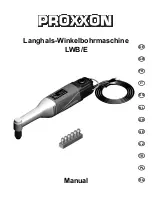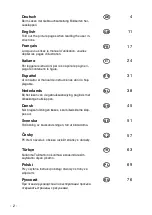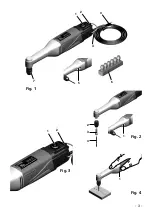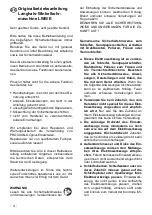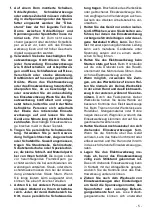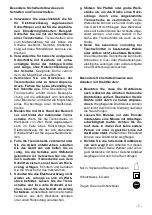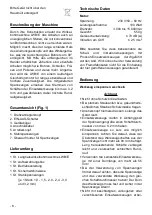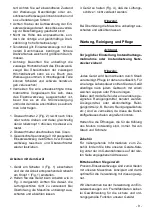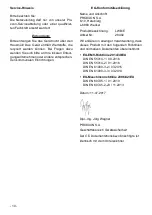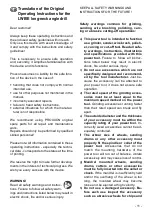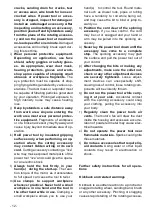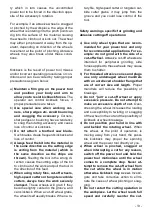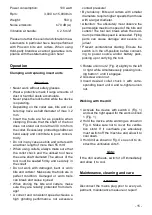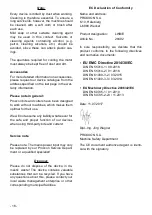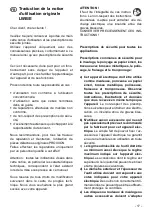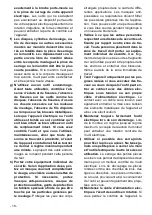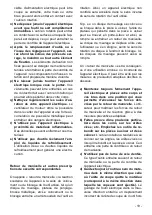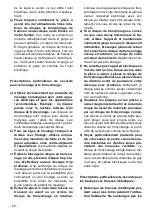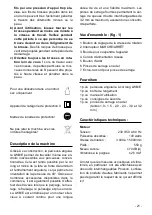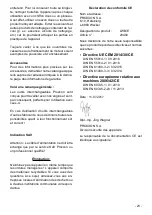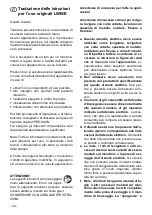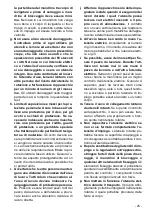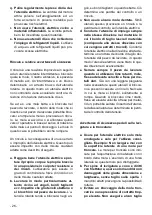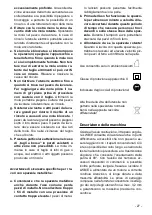
cracks, sanding drum for cracks, tear
or excess wear, wire brush for loose or
cracked wires. If power tool or acces-
sory is dropped, inspect for damage or
install an undamaged accessory. After
inspecting and installing an accessory,
position yourself and bystanders away
from the plane of the rotating accesso-
ry and run the power tool at maximum
no-load speed for one minute.
Damaged
accessories will normally break apart dur-
ing this test time.
i)
Wear personal protective equipment.
Depending on application, use face
shield, safety goggles or safety glass-
es. As appropriate, wear dust mask,
hearing protectors, gloves and work-
shop apron capable of stopping small
abrasive or workpiece fragments.
The
eye protection must be capable of stop-
ping flying debris generated by various op-
erations. The dust mask or respirator must
be capable of filtrating particles generated
by your operation. Prolonged exposure to
high intensity noise may cause hearing
loss.
j)
Keep bystanders a safe distance away
from work area. Anyone entering the
work area must wear personal protec-
tive equipment.
Fragments of workpiece
or of a broken accessory may fly away and
cause injury beyond immediate area of op-
eration.
k)
Hold power tool by insulated gripping
surfaces only, when performing an op-
eration where the cutting accessory
may contact hidden wiring or its own
cord.
Cutting accessory contacting a “live”
wire may make exposed metal parts of the
power tool “live” and could give the opera-
tor an electric shock.
l)
Always hold the tool firmly in your
hand(s) during the start-up.
The reac-
tion torque of the motor, as it accelerates
to full speed, can cause the tool to twist.
m)
Use clamps to support workpiece
whenever practical. Never hold a small
workpiece in one hand and the tool in
the other hand while in use.
Clamping a
small workpiece allows you to use your
hand(s)
to control the tool. Round mate-
rial such as dowel rods, pipes or tubing
have a tendency to roll while being cut,
and may cause the bit to bind or jump to-
ward you.
n)
Position the cord clear of the spinning
accessory.
If you lose control, the cord
may be cut or snagged and your hand or
arm may be pulled into the spinning ac-
cessory.
o)
Never lay the power tool down until the
accessory has come to a complete
stop.
The spinning accessory may grab
the surface and pull the power tool out of
your control.
p)
After changing the bits or making any
adjustments, make sure the collet nut,
chuck or any other adjustment devices
are securely tightened.
Loose adjust-
ment devices can unexpectedly shift,
causing loss of control, loose rotating com-
ponents will be violently thrown.
q)
Do not run the power tool while carry-
ing it at your side.
Accidental contact
with the spinning accessory could snag
your clothing, pulling the accessory into
your body.
r)
Regularly clean the power tool’s air
vents.
The motor’s fan will draw the dust
inside the housing and excessive accumu-
lation of powdered metal may cause elec-
trical hazards.
s)
Do not operate the power tool near
flammable materials.
Sparks could ignite
these materials.
t)
Do not use accessories that require liq-
uid coolants.
Using water or other liquid
coolants may result in electrocution or
shock.
Further safety instructions for all opera-
tions
Kickback and related warnings
Kickback is a sudden reaction to a pinched or
snagged rotating wheel, sanding band, brush
or any other accessory. Pinching or snagging
causes rapid stalling of the rotating accesso-
- 12 -
Содержание LWB/E
Страница 1: ...DE GB FR IT ES NL DK SE CZ TR PL RU Manual Langhals Winkelbohrmaschine LWB E ...
Страница 3: ...1 1 2 1 3 2 4 Fig 1 3 Fig 3 Fig 2 Fig 4 7 6 1 2 4 3 5 1 2 7 1 2 2 1 1 3 4 5 6 4 ...
Страница 86: ... 86 Notizen ...
Страница 87: ... 87 Notizen ...
Страница 88: ... 88 Notizen ...

